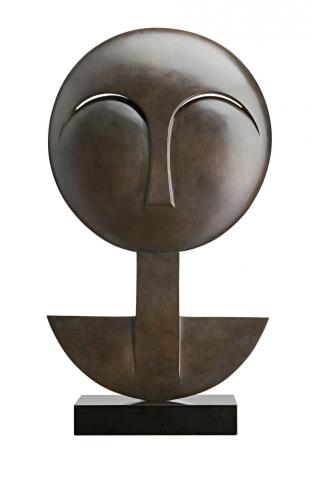MASK A, 1979-80
JOEL ELENBERG
bronze with black Belgian marble base
95.5 cm height including base
edition: 3/6
numbered at base: 3/6
stamped at base with Fonderia Mariani foundry mark: FONDERIA / M / ITALY
Anna Schwartz, Melbourne
Private collection, Melbourne, acquired from the above in 1994
Mask A, 1979–80, white statuary marble, 98.0 x 54.0 x 22.0 cm, executed in Italy at the S.G.F. Studios, Joel Elenberg 1979 – 1980, Robin Gibson Gallery, Sydney, 16 February – 6 March 1982
Mask A, bronze and Belgian marble, 95.0 x 53.0 x 23.0 cm (irregular), collection of the Monash University Museum of Art, Melbourne, Gift of Anna Schwartz, illus. in Duncan, J., and Michael, L., Monash University Collection: Four Decades of Collecting, Monash University Museum of Art, Melbourne, 2002, p. 95
With his interest in Aboriginal, Melanesian and Oceanic art, his obsession with time and evolution, and his talent for carving, Joel Elenberg represents one of the most important and original sculptors this country has produced.
Perhaps the most remarkable aspect of Elenberg's artistic evolution is that he only turned to carving stone four years before his untimely death at the age of 32. Disillusioned with the contemporary sculpture scene which he believed 'had fallen into disrepute with too much welding, fibre-glassing and clay,'1 Elenberg thus traveled to Italy in 1976 to pursue the ancient tradition of carving marble - a medium virtually unexplored in Australia at the time. Making the pilgrimage to Carrara, Tuscany - the home of marble sculpture since Michelangelo's time - he there discovered a whole village of carvers, artists and Italian masons who for generations had been cutting, carrying and chiseling blocks for some of the world's greatest monuments. As he gleaned their skills and techniques, Elenberg developed such empathy with these local artisans that he subsequently chose them to complete his final sculptures.
With its impeccable elegance and daring simplicity, the present Mask A, 1979-80 is an outstanding example of Elenberg's late sculptural oeuvre, which was so successful at the time of its inaugural exhibition that one critic was prompted to exclaim, 'he has the whole Sydney art world eating out of his hand!'2 One of the final and most refined works in his abruptly curtailed oeuvre, it is surely no coincidence that the piece bears unmistakable stylistic affinities with tribal African or Japanese funerary masks. As his close friend and celebrated artistic contemporary Brett Whiteley suggested, these closing works may be understood symbolically '... as a majestic attempt to pay homage to the great mysterious truth each of us in our own time must meet'.3 In its underlying conflict between medium and form, Mask A also perhaps reflects the artist's self-confessed dual personality - the soft and the lyrical with the tough and intellectual. The rich patina of the bronze bestows the work a sense of depth and solidity which is somehow betrayed by the flat, abstract simplicity of the facial features and wafer-like form. Similarly, that the bronze has been polished to sensuous perfection creates a further illusion of softness belying the harsh reality.
Revealing his enduring fascination with the power of ancient votive sculpture, the 'majesty of man' and the complex tactile qualities of bronze, indeed the present sculpture encapsulates Elenberg at his best - dignified, serene and always mysterious.
1. Brett Whiteley, cited in McGrath, S.,'Truth - in marble', The Weekend Australian Magazine, 20-21 February 1982, p. 8
2. McGrath, S.,'Marble star', The Weekend Australian, 14-15 October 1978, p. 6
3. Whiteley cited in McGrath, op. cit., p. 8
VERONICA ANGELATOS
